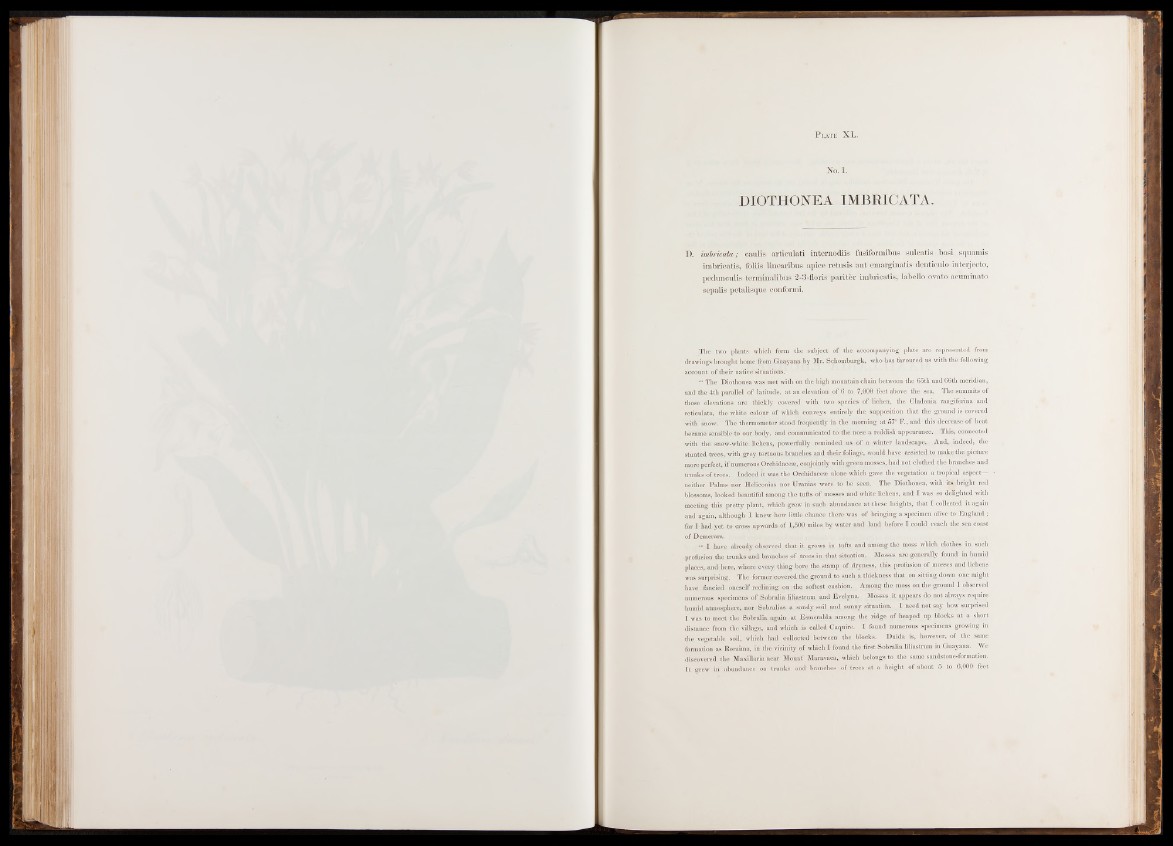
No. 1
DIOTHONEA IMBRICATA.
D. imbricata; caulis articulati internodiis fusiformibus suleatis basi squamis
imbricatis, foliis linearibus apice retusis aut emarginatis denticulo interjecto,
pedunculis terminalibus 2-3-floris paritèr imbricatis, labello ovato: acuminato
sepalis petalisque conformi.
-The two plants which form the subject of' the accompanying plate are represented from
drawings brought home from Guay ana by Mr. Schomburgk, who has favoured us with the following
account of their native situations.
“ The Diothonea was met with on the high mountain chain between the 65th and 66th meridian,
and the 4th parallel of latitude, at an elevation of 6 to 7,000 feet Above the sea. The summits of
those elevations are thickly covered with two species of lichen, thé Cladonia rangiferina and
reticulata, the white colour of which conveys entirely the supposition that the ground is covered
with snow. The thermometer stood frequently in the morning at 57° F., and this decrease of heat
became sensible to our body, and communicated to the nose a reddish appearance. This, connected
with the snow-white lichens, powerfully reminded us of a winter landscape. And, indeed, the
stunted trees, with,grey tortuous branches and their foliage, would have assisted to make the picture
more perfect, if numerous Orchidacese,, conjointly with green mosses, had not clothed the branches and
trunks of trees. Indeed it was the Orchidace® alone which gave the vegetation a tropical aspect—
neither Palms nor Heliconias nor Uranias were to be seen. The Diothonea, with its .’.bright red
blossoms, looked beautiful among the tufts of mosses and white lichens, and I was so delighted with
meeting this pretty plant, which grew in such abundance at these heights, that I collected it again
and again, although I knew how little chance there was of bringing a specimen alive to England ;
for I had yet to cross upwards of 1,500 miles by water and land before I could reach the sea coast
of Demerara.
“ I have already observed that it grows in tufts and among the moss which clothes in such
profusion the trunks and branches of trees in that situation. Mosses are generally found in humid
places, and here, where every thing bore the stamp of dryness, this profusion of mosses and lichens
was surprising. The former covered the ground to such a thickness that on sitting down one might
have fancied oneself reclining on the softest cushion. Among the, moss on the ground I observed
numerous specimens of Spbralia liliastrum and Evelyna. Mosses it appears do not always require
humid atmosphere, nor Sobralias a sandy soil and sunny situation, I need not say how surprised
I was to meet the Sobralia again at Esmeralda among the ridge of heaped up blocks at a short
distance from the village, and which is called Caquire. I found numerous specimens growing in
the vegetable soil, which had collected between the blocks. Duida is, however, of the same
formation as Roraima, in the vicinity of which I found the first Sobralia liliastrum in Guayana. We
discovered the Maxillaria near Mount Maravaca, which belongs to the same sandstone-formation.
It grew in abundance on trunks and branches of trees at a height of about 5 to 6,000 feet